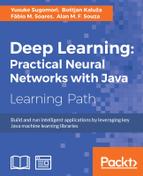In the previous chapters, we learned the concept, theory, implementation of deep learning, and how to use libraries. Now you know the basic technique of deep learning, so don't worry. On the other hand, development of deep learning is rapid and a new model might be developed tomorrow. Big news about AI or deep learning comes out one after the other every day. Since you have acquired the basic technique, you can learn about the upcoming new technologies on AI and deep learning quickly. Now, let's walk away from the details of techniques and think about what path the field of AI will or should take. What is the future of deep learning? For the closing chapter, let's think about that. We'll pick up the following topics in this chapter:
- Hot topics in the deep learning industry
- How to manage AI technologies
- How to proceed the study of deep learning further
As for the last topic, about further study, I will recommend a website about deep learning. You can stay ahead of the curve by thinking about what technology might come next, or leveraging the techniques you have learned to innovate, rather than following AI developments as they appear.
Deep learning, which triggered the AI boom, can't stop its momentum. New results are reported each day. As mentioned in Chapter 6, Approaches to Practical Applications – Recurrent Neural Networks and More, many researchers compete on image recognition and natural language processing. Of course, deep learning is not limited to these two fields, but applies to many other fields. The outcome of these applications is very exciting.
In this AI boom, in March 2016, the Go world was shaken by one event. Go is a board game in which two players are trying to take over more territory than their opponent. The news of 'AI beating a human in Go' shocked not only Go players but also the whole world, when a machine, that is, AI, beat a human at Go. DeepMind (https://deepmind.com/), which was bought by Google, has been developing the Go-playing AI, called AlphaGo, and AlphaGo has beaten world-class player Lee Sedol for a fourth time, to win the five-game series four games to one in Google's DeepMind Challenge Match. Each game was delivered on livestream via YouTube, and many people watched the games in real time. You can watch all five games on YouTube, if you haven't watched them yet:
In these games, the first match, Match 1, gained a particularly large amount of attention. Also, looking at the number of page views, which is more than 1.35 million, you can see that many people have watched the video of Match 4, which was the only match that AlphaGo lost to Lee Se-Dol. The following is an image which captured one scene of Match 1:

The moment AlphaGo beat Lee SeDol (https://www.youtube.com/watch?v=vFr3K2DORc8)
That was the moment at which not only researchers of AI, but also the world, were excited by AlphaGo; but why did this news got so much attention? For another board game example, in a chess match, Deep Blue, which was developed by IBM, beat the world chess champion in 1997. Of course, it became big news at that time, as this was also a moment when a machine beat a human. Why then, when this was not the first time a machine had beaten a human, was news of AlphaGo's triumph against Lee SeDol so world-shaking? What is the difference between Chess and Go? Well, the difference is in the complexity of the patterns of Go. In fact, Go has many more strategy patterns than Chess. In popular board games such as Chess, Shogi, and Go, the numbers of patterns to determine who wins or loses are as follows:
- Chess: 10,120
- Shogi: 10,220
- Go: 10,360
Even looking at the numbers, you can see how complicated the strategy of Go is and easily imagine that a machine also needs an enormous amount of calculation. Because of this huge number of patterns, until recently, people thought it was impossible for AlphaGo to beat a human, or that it would be 100 years or 200 years before AlphaGo would beat a human. It was considered impossible for a machine to calculate the patterns of Go within a realistic time. But now, in a matter of a few years, a machine has beaten a human. According to the Google research blog, 1.5 months before the DeepMind Challenge Match was held, DeepMind could predict the human's moves 57% of the time (http://googleresearch.blogspot.jp/2016/01/alphago-mastering-ancient-game-of-go.html). The fact that a machine won against a human definitely had an impact, but the fact that a machine could learn the strategy of Go within a realistic time was even more surprising. DeepMind applies deep neural networks with the combination of Monte Carlo tree search and reinforcement learning, which shows the width of the application range for the algorithm of deep neural networks.
